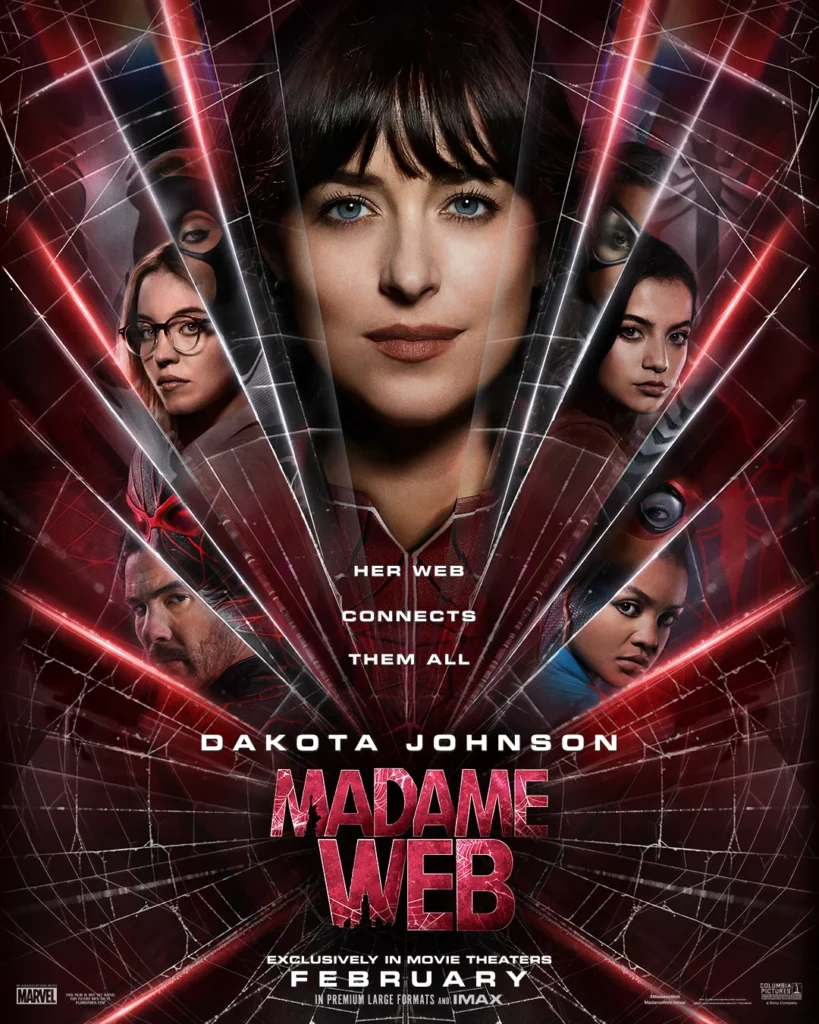Madame Web Movie Review – A Mixed Web of Potential
The Madame Web Movie struggles with a boring villain and poor CGI, yet shines in character dynamics and period setting, creating a flawed spin-off.

A Bold Leap Into the Spider-Verse
The Madame Web Movie sets out on an audacious journey to expand the horizons of the Spider-Man universe, venturing into uncharted territory with the introduction of novel characters and storylines. This bold initiative aims to enrich the iconic universe by exploring dimensions and narratives that diverge from the traditional paths tread by the beloved web-slinger. Despite the high ambitions and the promise of fresh adventures, the film grapples with considerable obstacles that mar its pursuit of innovation. These challenges, ranging from narrative inconsistencies to visual effects issues, significantly hamper the movie’s ability to fully realize its visionary goals, leaving fans and newcomers alike pondering what might have been in this expansive endeavor.
The Web of Relationships

A Villain Wrapped in Mediocrity

A critical misstep in the Madame Web Movie is its antagonist. Ezekiel Sims, portrayed by Tahar Rahim, emerges as a pivotal yet underwhelming antagonist. His character, a complex figure in the comics known for his mystical connection to the Spider-Verse and Spider-Man, fails to translate effectively onto the screen. Despite being endowed with powers mirroring those of Spider-Man, including enhanced strength, speed, and a form of spider-sense, Ezekiel’s portrayal in the film lacks the depth and menace needed to serve as a formidable foe against Madame Web and her allies.
In the comics, Ezekiel Sims is a rich businessman who gains his powers through a ritual connecting him to the Spider-Totem, setting the stage for conflicts with multiversal entities like Morlun. This backstory imbues him with a rich narrative potential, exploring themes of power, responsibility, and the mystical origins of the spider-powers. However, the film’s depiction of Ezekiel struggles to capture this complexity, instead presenting him as a somewhat generic villain whose motivations and abilities are not as compellingly explored as they could have been. His ability to see into the future, a trait that could have added a fascinating dynamic to his confrontation with Madame Web, is not leveraged to its full narrative potential, leaving audiences with a character that feels underdeveloped.
The introduction of Ezekiel Sims in the Madame Web Movie was an opportunity to delve into the more mystical and arcane aspects of the Spider-Man lore, potentially offering a fresh and intriguing antagonist who could challenge the protagonists in unique ways. Unfortunately, the execution falls short of these expectations, rendering him a character that, while possessing the outward trappings of a significant adversary, ultimately fails to leave a lasting impact on the narrative or the audience.
Visuals: A Tale of Two Webs

In the Madame Web Movie, the visual presentation is a mixed bag, creating a dichotomy that serves both as a feast and a famine for the eyes. On one hand, the Spider-Women’s costumes emerge as a beacon of creativity and attention to detail, capturing the essence of their comic book origins with a flair that respects both character history and contemporary design sensibilities. These costumes blend the iconic with the innovative, providing a visual treat that pays homage to the legacy of the characters while pushing the boundaries of superhero costume design. Their limited appearance on screen, however, left me craving more, hinting at a missed opportunity to fully showcase these visually arresting designs throughout the film’s narrative arc.
Conversely, the film’s visual effects and the villain’s costume design fall short of expectations set by the high standard of contemporary superhero cinema. Ezekiel Sims’ attire, in particular, lacks the sophistication and menace befitting a formidable antagonist in the Spider-Man universe. The costume fails to convey the depth and danger of his character, detracting from his presence on screen. Furthermore, the overall CGI quality fluctuates inconsistently, with some sequences achieving the spectacle you would anticipate from a Marvel-related film, while others suffer from a lack of polish that can momentarily dispel the film’s immersive experience.
This inconsistency in visual execution suggests a deeper issue within the film’s production, possibly indicating constraints in budget, time, or creative direction that prevented the visual effects from reaching their full potential. As these films increasingly rely on CGI to bring their fantastical elements to life, the disparity in quality within the Madame Web Movie underscores the importance of visual cohesion in sustaining the audience’s suspension of disbelief and engagement with the film’s universe.
The visual dichotomy within the Madame Web Movie—from the high of the Spider-Woman‘s costume design to the low of its CGI and villain’s attire—reflects a broader challenge in balancing artistic vision with the technical and financial realities of film production. While the film offers moments of visual brilliance that captivate and inspire, its inconsistencies serve as a reminder of the complex interplay between creativity and execution in the world of blockbuster filmmaking.
Dialogue and Delivery: Lost in Translation
The dialogue and delivery in the Madame Web Movie present notable obstacles in the film’s attempt to engage its audience. The script is marred by lines that often come across as awkward and stilted, not quite capturing the essence or the gravitas of the moments they’re meant to portray. This issue with the dialogue does more than just disrupt the flow; it creates a barrier between the characters and the audience, making it challenging to fully immerse oneself in the story’s unfolding drama.
Actors, even those with proven talent and range, find themselves wrestling with these lines, attempting to infuse them with a sense of realism and urgency that the script demands. However, the struggle is palpable, with the delivery often failing to resonate as intended. This disconnect is not a reflection of the actors’ abilities but rather an indication of the script’s failure to provide a solid foundation for performance. The dialogue, in its current form, lacks the naturalism and depth needed to convey the complex emotions and themes the Madame Web movie aims to explore.
The impact of this cannot be understated. Dialogue serves as the primary mode of communication between the characters and viewers, guiding the latter through the narrative landscape. When this dialogue feels unnatural or forced, it hinders the audience’s ability to engage with the characters’ journeys, reducing their emotional investment in the story. As a result, key moments that should elicit empathy, excitement, or understanding instead feel distant and unconvincing.
A Universe Without Its Spider

The absence of a Spider-Man in the Madame Web Movie underscores a significant challenge: navigating the vast Spider-Man universe without its central figure. This omission not only creates a noticeable void but also raises questions about how to effectively engage an audience that has grown accustomed to the web-slinger’s pivotal role in his eponymous universe. Spider-Man’s legacy, built on decades of comic book lore and cinematic achievements, imbues the universe with a sense of heroism, adventure, and moral complexity that fans have deeply connected with.
Attempting to expand this universe while sidelining its most iconic character is a bold move. It requires the introduction of compelling new characters and narratives strong enough to stand on their own. While the Madame Web Movie endeavors to do just that, by focusing on Cassie Web and her unique abilities, it navigates the tricky waters of fan expectations and the inherent draw of Spider-Man‘s charm and heroics. The film seeks to explore new dimensions and stories within the Spider-Verse, yet the shadow of Spider-Man’s absence looms large, reminding viewers of the gravitational pull of the original hero’s story.
This gap fundamentally highlights the intricacies of universe-building within superhero franchises. Fans are drawn to these universes not just for their expansive lore and the interconnectivity of their stories, but also for the characters that they’ve come to love and identify with. Removing Spider-Man from the equation challenges the Madame Web Movie to redefine what the Spider-Verse can be and to whom it can belong. It’s a test of the universe’s elasticity and its ability to evolve beyond the confines of its most famous character’s narrative.
Moreover, this absence speaks to the broader challenge of maintaining the essence of what draws fans to the Spider-Man universe—its heart, humor, and heroism—while venturing into new territory. The Madame Web Movie struggles to fill this void is indicative of the delicate balance required to honor the legacy of what came before while boldly stepping forward into the unknown. The film’s attempt to do so is a significant endeavor in its own right, reflecting both the potential and the pitfalls of expanding a beloved universe in new directions without its central hero.
The Madame Web Movie: A Step Above
While the Madame Web Movie manages to eclipse the reception of previous spin-offs like “Morbius,” it remains ensnared by its own ambitions. The film captures the essence of its 2003 setting effectively, yet this nostalgic achievement is overshadowed by its narrative and technical shortcomings.
In its quest to add new dimensions to the Spider-Man saga, the Madame Web Movie oscillates between moments of promise and pitfalls. While it endeavors to chart a new course within a beloved universe, the film is ultimately hampered by a lack of compelling villainy, inconsistent visual storytelling, and cumbersome dialogue. These elements weave a narrative that, though aspiring to greatness, falls short of the legacy the Madame Web Movie seeks to build upon.

